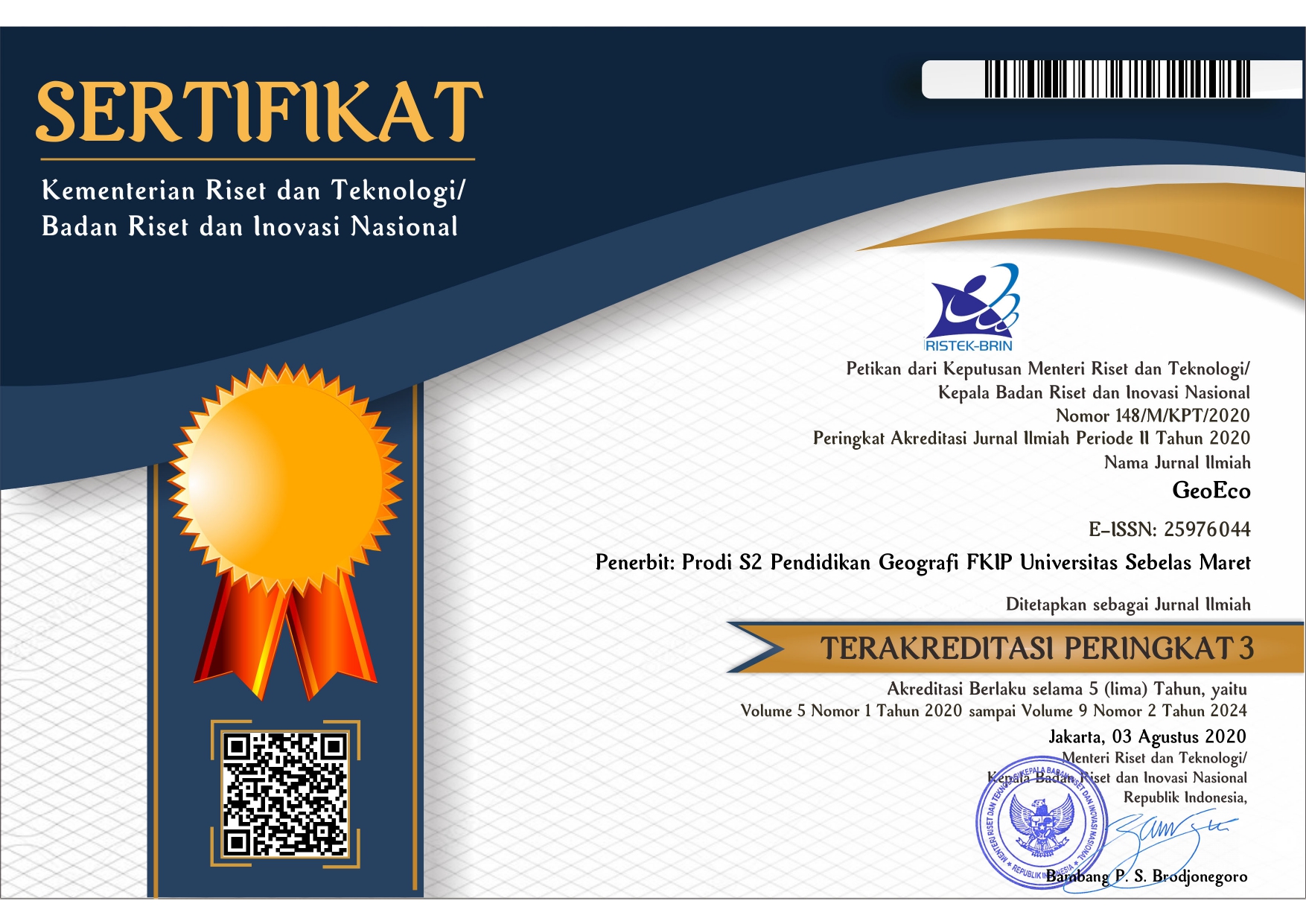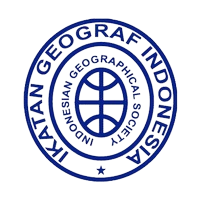WHAT ARE THE UNDERPINNING PREFERENCES OF THE PRACTICAL APPROACH TO DEVELOPING ENVIRONMENTAL GEOGRAPHY REFERENCE BOOKS IN UNIVERSITY?
Abstract
The need to analyse environmental geography reference books in tertiary institutions sets the stepping stones for the book writer’s consideration. Students’ needs are essential in investigating the initial key stages of developing a new reference book. This study aimed to analyse the needs of content preferences, geography skills, and design formats of Environmental Geography reference books. It employed a quantitative descriptive method with an online survey through Google Forms. Using the snowball technique, the research subjects were students enrolled in Environmental Geography courses in Indonesia during the odd semester in 2022. Data were analysed descriptively. The findings indicated that Environmental Geography knowledge, geography skills, and design were key requirements for developing reference books. The students were primarily concerned with content-based and geography skills in environmental geography, not with lectures. The development of digital technology has no impact on students because of the prevalence of printed versions of reference books. Implications of the results were the key to integrating content, skills, geography, and design in creating learning resource products in Indonesia.
Keywords
Full Text:
PDFReferences
Aksa, F. I., & Handoyo, B. (2019). A conceptual model of the geography textbook 21st century in enhancing thehigher order thinking skill. Journal of Physics: Conference Series, 1321(3), 0–5. https://doi.org/10.1088/1742-6596/1321/3/032109
Al-Nofli, M. A. (2010). Students’ perceptions about geography: A study of basic education school students in Oman. European Journal of Social Sciences, 16(1), 11–20.
Bednarz, R., & Lee, J. (2019). What improves spatial thinking? Evidence from the Spatial Thinking Abilities Test. International Research in Geographical and Environmental Education, 28(4), 262–280. https://doi.org/10.1080/10382046.2019.1626124
Behnke, Y. (2021). Usability qualities of ‘well-designed’ geography textbook visuals. Journal of Visual Literacy, 40(1), 15–33. https://doi.org/10.1080/1051144X.2021.1902042
Béneker, T., & van der Vaart, R. (2020). The knowledge curve: combining types of knowledges leads to powerful thinking. International Research in Geographical and Environmental Education, 29(3), 221–231. https://doi.org/10.1080/10382046.2020.1749755
Cox, M., Elen, J., & Steegen, A. (2019). Systems thinking in geography: can high school students do it? International Research in Geographical and Environmental Education, 28(1), 37–52. https://doi.org/10.1080/10382046.2017.1386413
D’Antoni, A. V., Zipp, G. P., & Olson, V. G. (2009). Interrater reliability of the mind map assessment rubric in a cohort of medical students. BMC Medical Education, 9(1), 1–8. https://doi.org/10.1186/1472-6920-9-19
Day, T. (2017). The contribution of physical geographers to sustainability research. Sustainability (Switzerland), 9(10). https://doi.org/10.3390/su9101851
Dove, J. (2012). Tropical rainforests: A case study of UK, 13-year-olds knowledge and understanding of these environments. International Research in Geographical and Environmental Education, 21(1), 59–70. https://doi.org/10.1080/10382046.2012.639150
Fowler, F. J. (2014). Survey Research Methods (5th edition). In Sage Publications, Inc. https://www.jstor.org/stable/3250956?origin=crossref
Handoyo, B., Astina, I. K., & Mkumbachi, R. L. (2021). Students’ environmental awareness and pro-environmental behaviour: Preliminary study of geography students at state university of malang. IOP Conference Series: Earth and Environmental Science, 683(1). https://doi.org/10.1088/1755-1315/683/1/012049
Handoyo, B., & Sukamto, H. (2019). Developing a Model of Geography Instructional Materials Based on the Spatial-Ecological Perspectives. IOP Conference Series: Earth and Environmental Science, 338(1). https://doi.org/10.1088/1755-1315/338/1/012043
Hill, J. L., & Jones, M. (2010). “Joined-up geography”: Connecting school-level and university-level geographies. Geography, 95(1), 22–32. https://doi.org/10.1080/00167487.2010.12094279
Hooghuis, F., Van Der Schee, J., Van Der Velde, M., Imants, J., & Volman, M. (2014). The adoption of Thinking Through Geography strategies and their impact on teaching geographical reasoning in Dutch secondary schools. International Research in Geographical and Environmental Education, 23(3), 242–258. https://doi.org/10.1080/10382046.2014.927168
Huckle, J. (2019). Powerful geographical knowledge is critical knowledge underpinned by critical realism. International Research in Geographical and Environmental Education, 28(1), 70–84. https://doi.org/10.1080/10382046.2017.1366203
Jitendra, A. K., Nolet, V., Xin, Y. P., Gomez, O., Renouf, K., Ishold, L., & DaCosta, J. (2001). An analysis of middle school geography textbooks: Implications for students with learning problems. Reading and Writing Quarterly, 17(2), 151–173. https://doi.org/10.1080/105735601300007606
Jo, I., & Bednarz, S. W. (2011). Textbook questions to support spatial thinking: Differences in spatiality by question location. Journal of Geography, 110(2), 70–80. https://doi.org/10.1080/00221341.2011.521848
Kučerová, S. R., Kučera, Z., & Novotná, K. (2018). Formation of a regional image through geography textbooks: The case of north-west Bohemia. Norsk Geografisk Tidsskrift, 72(3), 176–195. https://doi.org/10.1080/00291951.2018.1468811
Kurniawan, E., Saputra, Z. S., & Akhyar, M. (2024). Environmental Literacy and Responsibility Level of Students in the Geography Education Study Program in Universitas Negeri Semarang as Prospective Teachers. International Journal of Environmental Impacts, 7(2), 221–232. https://doi.org/10.18280/ijei.070207
Lambert, D. (2011). Reviewing the case for geography, and the “knowledge turn” in the English National Curriculum. Curriculum Journal, 22(2), 243–264. https://doi.org/10.1080/09585176.2011.574991
Larsen, T. B., & Harrington, J. (2021). a Human–Environment Timeline. Geographical Review, 111(1), 95–117. https://doi.org/10.1080/00167428.2020.1760719
Lawhon, M., & Le Roux, L. (2019). Southern urbanism or a world of cities? Modes of enacting more global urban geographical textbooks, teaching and research. Urban Geography, 40(9), 1251–1269. https://doi.org/10.1080/02723638.2019.1575153
Lee, J., & Catling, S. (2016). Some perceptions of English geography textbook authors on writing textbooks. International Research in Geographical and Environmental Education, 25(1), 50–67. https://doi.org/10.1080/10382046.2015.1106204
Lee, J., & Catling, S. (2017). What do geography textbook authors in England consider when they design content and select case studies? International Research in Geographical and Environmental Education, 26(4), 342–356. https://doi.org/10.1080/10382046.2016.1220125
Lee, J., Catling, S., Kidman, G., Bednarz, R., Krause, U., Martija, A. A., Ohnishi, K., Wilmot, D., & Zecha, S. (2021). A multinational study of authors’ perceptions of and practical approaches to writing geography textbooks. International Research in Geographical and Environmental Education, 30(1), 54–74. https://doi.org/10.1080/10382046.2020.1743931
Maude, A. (2020). The role of geography’s concepts and powerful knowledge in a future 3 curriculum. International Research in Geographical and Environmental Education, 29(3), 232–243. https://doi.org/10.1080/10382046.2020.1749771
Mellawen, Zannah, F., & Elhawwa, T. (2024). Studentsâ€TM and Teachersâ€TM Perception on the Development of Local Wisdom Module to Increase Student Learning Outcome. Jurnal Penelitian Pendidikan IPA, 10(2), 516–521. https://doi.org/10.29303/jppipa.v10i2.5063
Mili, & Winch, C. (2019). Teaching through textbooks: Teachers as practitioners of a discipline? Theory and Research in Education, 17(2), 181–201. https://doi.org/10.1177/1477878519862547
Mitchell, D. (2022). GeoCapabilities 3—knowledge and values in education for the Anthropocene. International Research in Geographical and Environmental Education, 31(4), 265–281. https://doi.org/10.1080/10382046.2022.2133353
Morgan, J. (2002). “Teaching geography for a better world”? The postmodern challenge and geography education. International Research in Geographical and Environmental Education, 11(1), 15–29. https://doi.org/10.1080/10382040208667460
Okeeffe, L. (2013). A Framework for Textbook Analysis. International Review of Contemporary Learning Research, 2(1), 1–13. https://doi.org/10.12785/irclr/020101
Parker, L., Prabawa-Sear, K., & Kustiningsih, W. (2018). How young people in Indonesia see themselves as environmentalists: Identity, behaviour, perceptions and responsibility. Indonesia and the Malay World, 46(136), 263–282. https://doi.org/10.1080/13639811.2018.1496630
Platt, N. (2018). Powerful knowledge and the textbook. London Review of Education, 16(3), 414–427. https://doi.org/10.18546/LRE.16.3.05
Purwanto, E., Fatchan, A., -, P., & Soekamto, H. (2015). Development of Geography Text Books Used by Senior High School Teachers Case Study at East Java-Indonesia. Journal of Education and Learning, 5(1), 60. https://doi.org/10.5539/jel.v5n1p60
Reinfried, S., Aeschbacher, U., Kienzler, P. M., & Tempelmann, S. (2015). The model of educational reconstruction - A powerful strategy to teach for conceptual development in physical geography: The case of water springs. International Research in Geographical and Environmental Education, 24(3), 237–257. https://doi.org/10.1080/10382046.2015.1034459
Rey-Goyeneche, J. A., & Alexander, P. (2021). Wolves in the Amazon? Child perceptions of a distant natural environment in an English primary school. International Research in Geographical and Environmental Education, 30(2), 132–147. https://doi.org/10.1080/10382046.2020.1797099
Ridha, S., Utaya, S., Bachri, S., & Handoyo, B. (2019a). Evaluating Disaster Instructional Material Questions in Geography Textbook: Using Taxonomy of Spatial Thinking to Support Disaster Preparedness. IOP Conference Series: Earth and Environmental Science, 273(1). https://doi.org/10.1088/1755-1315/273/1/012035
Ridha, S., Utaya, S., Bachri, S., & Handoyo, B. (2019b). Students’ geographic skills in indonesia: Evaluating gis learning material questions using taxonomy of spatial thinking. Journal of Social Studies Education Research, 10(4), 266–287.
Ridha, S., Utaya, S., Bachri, S., Handoyo, B., Kamil, P. A., & Abdi, A. W. (2021). Spatial Thinking and Decision-Making Abilities to Learn about Disaster Preparedness. IOP Conference Series: Earth and Environmental Science, 630(1). https://doi.org/10.1088/1755-1315/630/1/012017
Saleh, A., & Bista, K. (2017). Examining factors impacting online survey response rates in educational research: perceptions of graduate students. Journal of MultiDisciplinary Evaluation, 13(29), 63–74. https://journals.sfu.ca/jmde/index.php/jmde_1/article/view/487/439
Schubert, J. C. (2015). Causes, processes and consequences of “desertification”: Results of a qualitative study about the conceptions of 12- and 13-year-old students in Germany. International Research in Geographical and Environmental Education, 24(2), 148–166. https://doi.org/10.1080/10382046.2014.993172
Sidorov, D. (2009). Visualizing the former cold war “other”: Images of Eastern Europe in world regional geography textbooks in the United States. Journal of Educational Media, Memory, and Society, 1(1), 39–58. https://doi.org/10.3167/jemms.2009.010104
Sikorov, Z., & Conference, I. (2021). Textbooks and Educational Media: Perspectives from Subject Education. In Textbooks and Educational Media: Perspectives from Subject Education. https://doi.org/10.1007/978-3-030-80346-9
Simon, M., & Budke, A. (2020). How geography textbook tasks promote comparison competency—an international analysis. Sustainability (Switzerland), 12(20), 1–19. https://doi.org/10.3390/su12208344
Simon, M., Budke, A., & Schäbitz, F. (2020). The objectives and uses of comparisons in geography textbooks: results of an international comparative analysis. Heliyon, 6(8). https://doi.org/10.1016/j.heliyon.2020.e04420
Solem, M., Kollasch, A., & Lee, J. (2013). Career goals, pathways and competencies of geography graduate students in the USA. Journal of Geography in Higher Education, 37(1), 92–116. https://doi.org/10.1080/03098265.2012.729563
Stigler, J. W., Son, J. Y., Givvin, K. B., Blake, A. B., Fries, L., Shaw, S. T., & Tucker, M. C. (2020). The better book approach for education research and development. Teachers College Record, 122(9). https://doi.org/10.1177/016146812012200913
Sumarmi, Bachri, S., Mutia, T., Yustesia, A., Fathoni, M. N., Muthi, M. A., & Nuraini, S. G. (2020). the Deep Ecology Persepective of Awig-Awig: Local Tribal Forest Preservation Laws in Tenganan Cultural Village, Indonesia. Journal of Sustainability Science and Management, 15(8), 102–113. https://doi.org/10.46754/JSSM.2020.12.009
Sumarmi, Bachri, S., Purwanto, Sholiha, A. W., Zubaidah, S., & Shrestha, R. P. (2022). Assessing Bedul Mangrove Ecotourism Using Green and Fair Strategy Empowerment to Fulfill SDGs 2030 Agenda for Tourism. Environmental Research, Engineering and Management, 78(2), 73–87. https://doi.org/10.5755/j01.erem.78.2.31006
Sumarmi, Wahyuningtyas, N., Sahrina, A., & Aliman, M. (2022). The Effect of Environmental Volunteer Integrated with Service Learning (EV_SL) to Improve Student’s Environment Care Attitudes and Soft Skills. Pegem Egitim ve Ogretim Dergisi, 12(1), 168–176. https://doi.org/10.47750/pegegog.12.01.16
Sumarmi, Wahyuningtyas, N., Sahrina, A., & Mutia, T. (2022). Analysis of the potential bamboo forest as an effort towards local wisdom-based ecotourism in sustainable spring conservation. Journal of Ecology and Environment, 46. https://doi.org/10.5141/jee.22.032
Vasantha, R. N., & Harinarayana, N. S. (2016). Online survey tools : A case study of Google Forms Online. Scientific, Computational & Information Research Trends in Engineering, 1, 1–12. https://www.researchgate.net/publication/326831738
Yang, D. (2013). Comparing Assessments Within Junior Geography Textbooks Used in Mainland China. Journal of Geography, 112(2), 58–67. https://doi.org/10.1080/00221341.2011.648211
Refbacks
- There are currently no refbacks.












.png)

